|
|
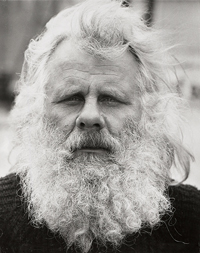
|

|
Viktor IV, an American in Amsterdam
by Ad Petersen
From 1961 until his death in 1986, a conspicuous
character, an artist who called himself Viktor IV
(Viktor Four), lived and worked in Amsterdam.
|
|
Click on image to
enlarge
|
|
|
|
|
|
|
|
|
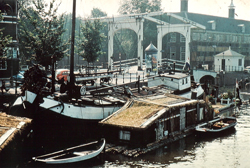
|
|
Amstel River
Viktor IV lived under primitive conditions on an old
cargo ship which was moored along the Amstel River in
the center of Amsterdam near the Blauwbrug.
The ship became a well-known phenomenon in Amsterdam,
as it was covered with wild constructions, rigged up
with flags and banners and surrounded by overgrown
rafts on which huts and quite a menagerie of ducks,
chickens and colorfully painted cats. Texts such as
'WHO NEEDS THE PACIFIC OCEAN' or 'THE SECOND QUALITY
CONSTRUCTION COMPANY' or 'THE TIME IS ALWAYS NOW'
attracted the attention of passers-by. From the stern
of the ship a Dutch flag was flying with the words
'THANK YOU AMSTERDAM'.
|
|
|
|
|
Youth
Viktor IV or Jack Sun, Bulgar or Bulgar Finn (as he
later named himself) was born in 1929 in New York City
as Walter Karl Glück. His parents were European
immigrants. His father was from Germany, his mother
came from Greece.
In elementary school Walter was stubborn and
disobedient. He was intelligent but had difficulty
dealing with authority. He attended college in Florida
where he majored in Journalism and Communication,
focusing on photo journalism. He supported himself with
various jobs. Restlessness and an urge for independence
led him abroad. He traveled to Mexico and Peru, lived
and worked in Korea and Japan for a while. He roamed
around Europe from country to country living in a
Renault Estafette (Spain, Italy, Portugal, Holland,
Denmark, Sweden, England and the Soviet Union).
|

|
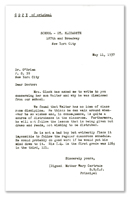
|
|
|
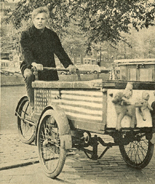
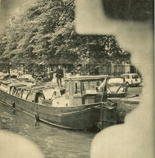
|
|
He became strongly attracted to
the liberal city of Amsterdam, where he obtained a
residence permit in 1961. Yet also there the solid
ground under his feet seemed a bit too much for him. He
created his own living space on an old ship that was
connected to the quay by a dangerously narrow plank
only.
|
|
|

|
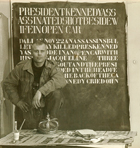
|
|
Debut as a painter
The assassination of the American President John F.
Kennedy in November 1963 had an enormous impact on
Viktor IV. He realized that as a photographer one had
to be on the spot to be able to make a picture. At the
same time he became aware that there were also other
ways to comment on events. In April 1964 he made his
first painting, a text based on the assassination of
Kennedy made with white stencil letters on a black
background. It was the beginning of his career as an
artist and from that moment on he called himself Viktor
IV.
|
|
|
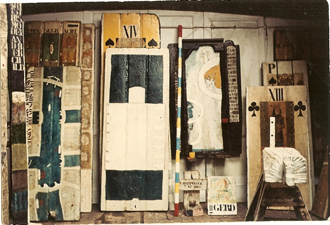
|
|
'Ikons'
During the first few years Viktor IV's work consisted
of numerous panels which he called 'Ikons'. They were
made of driftwood, which he collected from the canals
in and around Amsterdam, dried and then painted. He
named his work 'The New Amsterdam School of Ikon
Painting'. It was a true explosion of creativity,
consisting of quasi-primitive images scratched in wood.
The panels were sober in color and always carrying
words in stenciled letters, as a title or
explanation.
|
|
|
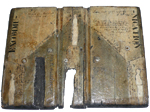
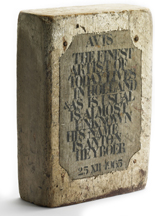
|
|
Inspiration
Two sources inspired Viktor in his work. Firstly, the
thoughts and the ideas of the American Henry David
Thoreau, author of 'Walden' and 'Civil Disobedience'.
Secondly, the work and the alternative life style of
the Dutch artist Anton Heyboer. Unlike Heyboer, Viktor
could always be found in the city, riding his painted
bike or carrier-tricycle, dressed in black with a white
beard and always barefooted.
He was constantly in search of social contact,
preferably with young women and looking for material or
subjects for his work.
|
|
|
|
|
Logbook pages
At the end of the '60s, after producing hundreds of
'Ikons', Viktor began his work on paper. His
startingpoint was always a sheet of A-4 size paper,
glued onto a paper twice as large. Each sheet was
stamped with the date and big numerals marking the
number of the month since April 1964.
These grew into thousands of pages, usually with typed
texts (Viktor was a good writer) and illustrated with
drawings. The texts were based on stories, memories, or
comments on what he had experienced. But also
anecdotes, myths or whatever crossed his mind. These so
called 'logbook pages', all loose pages, were gathered
in folders, which he called 'books', with titles such
as 'The Big Fool, 'Thank you Silent Sun', 'Who Can
Betray the Sun', 'The Post is a perhaps' or 'The Truth
Always Happens'.
|
|
|
|
|
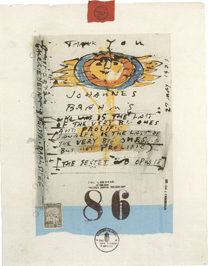
|
|
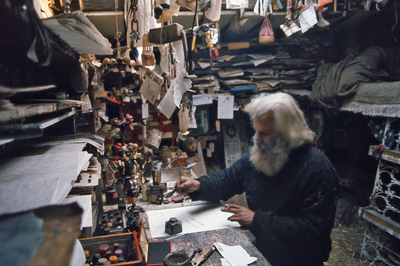
|
|
|
|
|

|
|
Bulgar Time
During the '80s Viktor IV focused with great enthusiasm
on time. He had watches and clocks made with numbers
counting to the left and hands turning
counter-clockwise.
He designed clocks with various systems and speeds,
both ingenious and confusing, which were marketed under
the name 'Bulgar Time'. He was still very much engaged
in his work, when he drowned in the Amstel River in
1986.
|
|
|
|
|
Exhibitions
Viktor IV's work, all of which was made in Amsterdam,
was that of a maverick artist. His work did not seem to
fit too well in contemporary art, but eventually it
did. Museums including the Stedelijk Museum in
Amsterdam, the Van Abbemuseum in Eindhoven, the Ny
Carlsberg Glyptotek and the Louisiana Museum in
Denmark, as well as national and international
galleries, such as New York's Lefebre Gallery,
organized exhibitions.
|
|
|
|
|
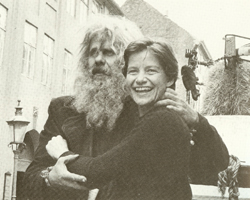
|

|
Ina Munck
In 1988 a book on Viktor IV was published in Amsterdam
with intense cooperation from Ina Elisabeth Munck,
Viktor's Danish wife and collaborator. It was edited by
Ad Petersen, at that time curator at the Stedelijk
Museum of Amsterdam.
In 2006, due to the ongoing interest in Viktor's work,
a Viktor IV Foundation was established in Amsterdam, in
consultation and with approval of Ina Munck.
The foundation's goal is to promote his work through
exhibitions and publications and to find a suitable
location for his estate.
|
|
|
|
|
|
Ref.: Viktor IV. Ad Petersen
& Ina Munck. Ed. Meulenhoff/Landshoff & The
second Quality Construction Company, 1988
|















